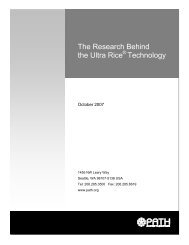STD Management for HIV and AIDS Prevention - Path
STD Management for HIV and AIDS Prevention - Path
STD Management for HIV and AIDS Prevention - Path
You also want an ePaper? Increase the reach of your titles
YUMPU automatically turns print PDFs into web optimized ePapers that Google loves.
eportedly often took inappropriate drugs based on advice from friends<br />
or even unin<strong>for</strong>med health providers or took antibiotics <strong>for</strong> a couple of<br />
days until symptoms disappeared. In a 1993 study, 89 percent of female<br />
sex workers reported taking antibiotics to protect themselves from <strong>STD</strong>s<br />
<strong>and</strong> <strong>HIV</strong>. [2] This practice is not only ineffective, it can lead to increased<br />
antimicrobial resistance. [18] With the growing body of evidence showing<br />
sexually transmitted infection (STI) as a co-factor <strong>for</strong> <strong>HIV</strong>/<strong>AIDS</strong><br />
transmission, in 1996 USAID added improved <strong>STD</strong> management to<br />
ASEP’s prevention strategies.<br />
ASEP’s <strong>STD</strong> Component<br />
Risky sexual behavior had been found among all sentinel groups in all<br />
ASEP cities. In 1994, ASEP’s surveillance component included testing<br />
blood samples <strong>for</strong> syphilis as well as <strong>HIV</strong>, revealing high syphilis rates <strong>and</strong><br />
validating that risky sexual behavior was common. For example, in 1994<br />
freelance sex workers had syphilis rates ranging from 4 percent in Quezon<br />
<strong>and</strong> Pasay, to 12 percent in Davao <strong>and</strong> 16 percent in Angeles. Among<br />
MSMs, the figures ranged from 5 percent in Cebu <strong>and</strong> Davao, to 11<br />
percent in Quezon <strong>and</strong> Angeles. [32] This suggested a serious potential<br />
<strong>for</strong> widespread <strong>HIV</strong> transmission. And although the promotion of safer<br />
sexual practices was the centerpiece of the ASEP education program, WHO<br />
also recommends reduction in the incidence <strong>and</strong> duration of curable <strong>STD</strong>s<br />
as an important strategy in preventing <strong>HIV</strong> transmission. This is based on<br />
evidence that people with <strong>STD</strong>s are more susceptible to <strong>HIV</strong> infection if<br />
exposed, [7] <strong>and</strong> that those with <strong>HIV</strong> <strong>and</strong> concurrent <strong>STD</strong> infections<br />
may be more infectious. [8]<br />
6<br />
<strong>STD</strong> management <strong>for</strong> <strong>HIV</strong> <strong>and</strong> <strong>AIDS</strong> prevention

















